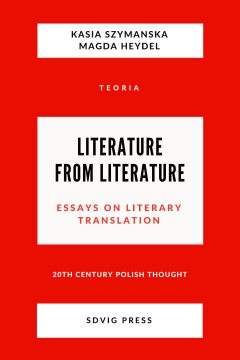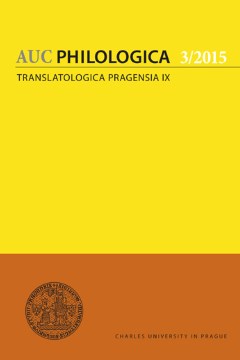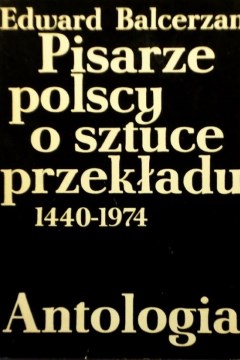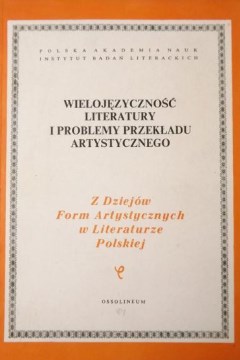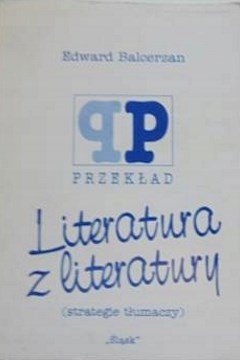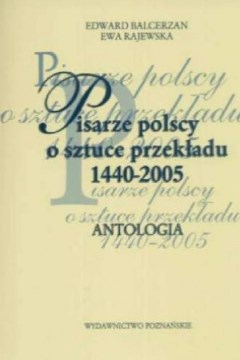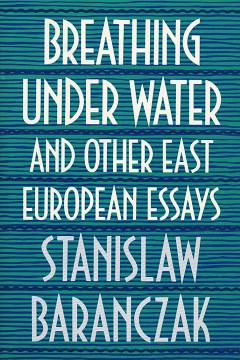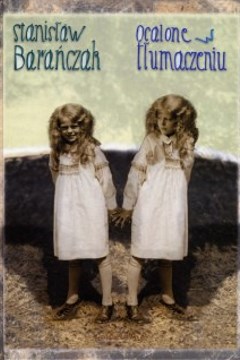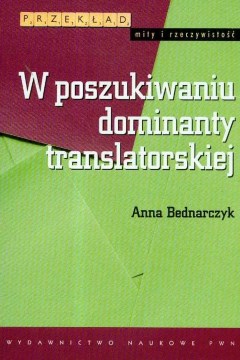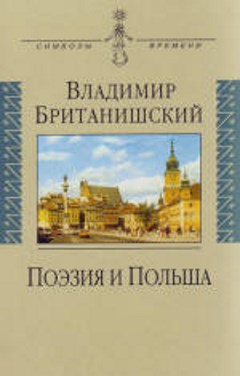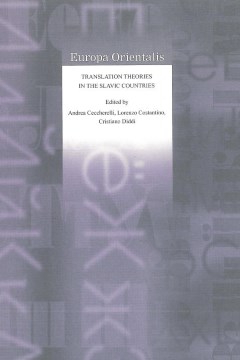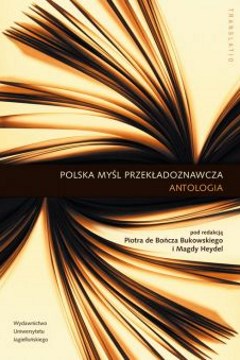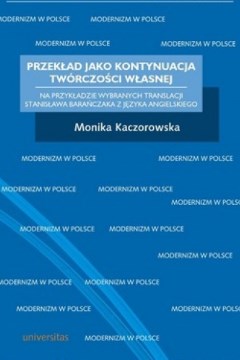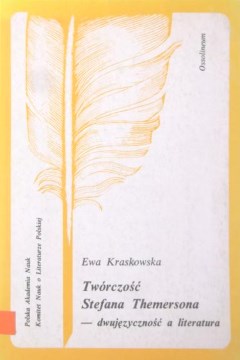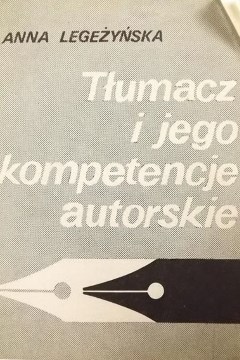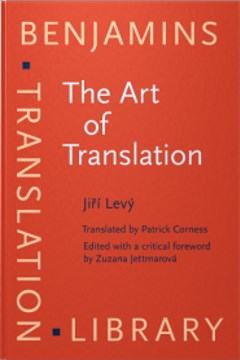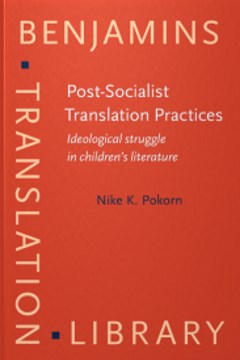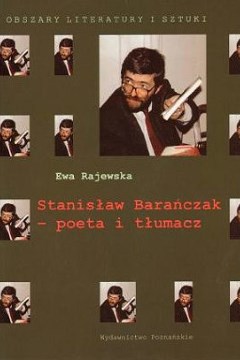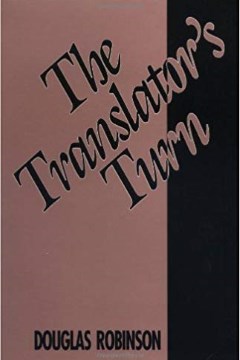Translating Balcerzan and Barańczak into English Szymanska Kasia; Archiving of XML in sdvig press database Open Commons September 7, 2019, 11:31 am ( )
A Battle of the Opposites: the Mentor and the Practitioner
1Witold Gombrowicz’s novel Ferdydurke features a famous interlude in which two professors enter into a grotesque duel, first of words, then of actions. Senior synthetist Philidor, professor of Synthetology at the University of Leiden, is confronted by his alter ego, Anti-Philidor, professor of Higher Analysis at Columbia University. Their academic methods and intellectual positions are as divergent as synthesis and analysis could possibly be: whereas Philidor specializes in combining parts into a whole, Anti-Philidor prefers to break things into parts. Clichéd as it may be, this scholarly duo remains unforgettable in the Polish literary tradition, and the opposition of these methods still profoundly resonates in Polish culture and with Polish readers.
2It is perhaps not too far-fetched to state that the two authors of the essays on literary translation collected in this volume, Edward Balcerzan (b. 1937) and Stanisław Barańczak (1946-2014), have gone down in the Polish history of literary translation as approximate equivalents of Gombrowicz’s professorial types. Balcerzan is known primarily as the author of “theory-orientated contributions” to Polish translation studies, written in the spirit of East European structuralism (Cf. Tabakowska 1998, 530). As for Barańczak—the most prominent Polish translator of anglo|phone verse and a leading figure of the tradition often referred to as Generation 1968 (or Nowa Fala [New Wave])—he represents the more analytic or critical branch of the discipline: his approach consists in dissecting “individual case studies”, without providing a more comprehen|sive framework for his ensuing “fragmented comments” (Tabakowska 1998, 530). At the same time, both Balcerzan and Barańczak harken back to the same academic tradition and their ideas are firmly wedded to a unique legacy, that of the Poznań structuralist circle. It was in Poznan that, years before emigrating to the United States in 1981, the then student Barańczak first encountered Balcerzan, a young scholar nine years his senior and initially his mentor (Barańczak 1987, 10). It was in Poznan that the two later became colleagues and friends and contributed collabora|tively to what came to be called the Poznań Translation School.1 And it was in Poznan that, from the 1960s onwards, Polish research on literary translation found its most dynamic and promising center, nourished by Eastern European structuralism, literary communication theory and semiotic studies. In light of this shared background, can we thus really read Barańczak’s and Balcerzan’s texts on translation as paragons of two diametrically opposed methodological frameworks? Did our two authors effectively clash in an intellectual duel over how to understand and approach the art of translation—one of them weaving translation examples into a greater and more general theory of literary translation, the other using analytic concepts to break translation phenomena down into their constituent parts and individual instances?
3Although Barańczak and Balcerzan’s paths crossed on both personal and academic levels many times, they certainly bifurcated in certain aspects of their lives and scholarly profiles. On the one hand, Balcerzan is usually portrayed as the intellectual mentor of the entire Poznań trans|latological tradition, of which he remained “the most distinguished and recognizable academic representative” (Kraskowska 2015, 123, my emphasis).2 According to Jerzy Ziomek—a Poznań scholar who conflates stylistic analysis and theory of information in his work on translation—Balcerzan officiated as the uncontested leader of the research group, inspiring or supervising the academic work on translation of the other prominent figures of the Poznań collective. In addition to Barańczak, Balcerzan particularly influenced two women scholars: Anna Legeżyńska and her text on the translator’s authorial competences, Tłumacz i jego kompetencje autorskie (1986), and Ewa Kraskowska, whose book on Stefan Themerson’s multilingual writing (Polish-English-French) and self-translation, Twórczość Stefana Themersona (1989), was an explicit conti|nuation of Balcerzan’s early research.
4In his dissertation, Styl i poetyka twórczości dwujęzycznej Brunona Jasień|skiego [The style and poetics of Bruno Jasieński’s bilingual writing] (1968), Balcerzan had indeed championed a similar interlingual approach—something that was unprecedented in Polish literary studies at the time—by highlighting the Polish-Russian literary bilingualism of the futurist poet Bruno Jasieński. It is therefore perhaps no coincidence that Balcerzan became a driving force of Polish research on self-translation, literary multilingualism, and other translingual and transnational studies. Having grown up in Ukraine and acquired Russian before he began writing in Polish, he himself lived between languages and pursued bilingual scholar|ship at the intersection of Polish and Russian. Very well-read in the traditions of Russian Formalism, the Tartu School of Semiotics as well as East European structuralism, Balcerzan was able to aptly transplant their original literary apparatus onto the grounds of literary translation in Polish. Not only are his theoretical works strongly wedded to these tradi|tions, but the examples with which Balcerzan supported his arguments also draw primarily from Russian literature in Polish translation (or the other way around), fostering the development of translation studies across these two cultures. All his major theoretical concepts and ideas about translation remained faithful to this spirit, a feature that is manifest in the selection of essays published in this volume.
5If Balcerzan emerges from this traditional characterization as the mentor and theoretician, his counterpart, Stanisław Barańczak, usually passes as the translation critic and practitioner. While Balcerzan is cast in the role of theacademic representative of the Poznań circle, Barańczak appears as “the most celebrated literary one […], whose poetry and art of translation have earned him an international reputation” (Barańczak 1968, 123, my emphasis). Building on his debut in the 1960s, Barańczak grew into a leading figure of the poetic group formed in the aftermath of the student protests against the Polish communist government in March 1968. Owing to his “poetry of distrust”—which unmasked the totalizing language of official newspeak—and to his dissident activity in the Workers’ Defense Committee (KOR), Barańczak was banned from publi|shing; he was also suspended from his university position. In 1981, he emigrated to the United States to take up the chair of Polish language and literature at Harvard University. During this period of intense immersion in a different linguistic and cultural world, he produced literary trans|lations and translation criticisms in unparalleled volume and intensity. Most of this output eventually appeared in print in Poland after the political watershed of 1989. Next to innumerable translations from the English poetry canon—spanning several centuries and including authors from Chaucer to Shakespeare, as well as metaphysical, romantic, modern, and contemporary poets—Barańczak also published playful and experi|mental translation anthologies, didactic essays featuring examples from his own translations, as well as self-translations and co-translations (with Seamus Heaney or Clare Cavanagh) of Polish poetry into English. The scope and quality of this impressive activity led Czesław Miłosz to dub him a “genius” and a translation “shaman” (cf. Haven 2015).
6A number of further differences can be roughly sketched out between our two figures. In contrast to Balcerzan—who dedicated himself primarily to the Russian intellectual and literary tradition—Barańczak worked to fill gaps in the Polish reception of the Western canon. His inclinations towards English literature (with occasional excursions into German or Russian material) made him an unchallenged champion of English-Polish cultural transfers—which had never before been stimulated through translations to such a great extent. In this respect, the confron|tation of Balcerzan’s and Barańczak’s texts with the gradually growing geographical distance in their areas of interest and styles of academic writing also serves as a testament to the changing political landscape of the time. While Balcerzan stayed put in his native country and remained faithful to his methodological framework, Barańczak’s previously strong structuralist affiliation was partly disrupted by his emigration to the other side of the Iron Curtain. As the communist system in Poland started failing, his work on the art of translation began shifting to criticism of the Polish translation context, written both from afar and from the perspective of an outside commentator. It was not until the early 1990s that Barańczak’s texts on translating anglophone literature—along with his actual renderings of Shakespeare and the English classics—started appearing in official print in Poland. Perhaps not entirely by accident, the transition from a Soviet to an Anglo-American political and cultural dominance in Poland overlapped with the moment when Barańczak’s translations, because they filled many gaps in the translated canon, found an incredibly fertile ground among Polish readers.
7Though widely taken for granted, the contrast between Balcerzan as the mentor and theorist and Barańczak as the practitioner and critic of literary translation is quite rough-grained. Indeed, both figures possess many other creative faces and took on various roles and different literary persona. In Balcerzan’s case, for example, besides teaching at university, he was also a poet and translator of Russian poetry in his own right. He published five books of poetry of his own, as well as translations of Boris Pasternak and Gennadiy Aygi. His early artistic activity and linguistic poetry inspired many poets from the succeeding generation. As the Russian poet and translator Vladimir Britanishsky notes, “some of the ‘New Wave’ poets, or at least those from Poznań, pointed to Witold Wirpsza and Edward Balcerzan as their masters or direct predecessors” (Britanišskij 2007, 295). This was certainly the case of Barańczak and of the entire 1968 formation who continued that earlier tradition of linguistic poetry by making their own writing vigilant and attentive to linguistic nuance in confrontation with the political reality of the time.
8Ironically, the title of “battle of the opposites” chosen for this introduction comes from a Barańczak essay devoted to Balcerzan’s poetry of the 1960s. Entitled “Edward Balcerzan albo Walka przeciwieństw” [Edward Balcerzan, or: a battle of the opposites] (Barańczak 1971, 98), Barańczak’s text discusses his colleague’s linguistic poems in terms of a clash between a conflicted reality and a language that tacitly attenuates any tensions in the world it describes. Besides encapsulating a methodological dualism redolent of the structuralist approach, this text also reveals Barańczak’s deep suspicion of language and his ensuing need to dismantle, as Bakhtin would have it, “the other’s word”. This creed left an imprint both on the poetic activity and on the intensive translation activity and underground publications (cf. Luboń 2013) of the entire 1968 generation—including Barańczak himself and figures such as Ryszard Krynicki or Julian Kornhauser. After all, both Balcerzan and Barańczak knew that by translating the words of others into their own language—into a specific literary culture and at a specific moment in time—it was possible to both comment artistically on the original and to formulate a firm intellectual stand of their own. This shared idea of literary translation as a practice that is essentially formative and constructive underpins some of the theoretical concepts featured in the present collection of essays.
9As for Barańczak, it is also the case that he does not fit squarely into the “translation practitioner” and “translation essayist” pigeonholes. As much as his analyses are largely informed by his vast experience of translating poetry, his critical texts are still very much “anchored in the findings of the Poznań School” (Bukowski & Heydel 2015, 149) and remain within the sphere of influence of his predecessors. True, Barańczak always uses individual cases as points of departure for his more general arguments. This trait recurs in the essays collected here, which are constructed as if they were written “on the margins of” translations from poets such as Gottfried Benn, Gerald Manley Hopkins, George Herbert, John Donne, Elizabeth Bishop and many others. At the same time, the key concepts adopted by Barańczak to dissect these examples strongly echo formalist and structuralist ideas—even if he never explicitly acknowledges any theoretical framework. While derived principally from Anton Popovič’s understanding of translation as a meta-text, Barańczak’s 1974 concept of translation as a self-sufficient and integrated object of interpretation implicitly relies on Balcerzan’s ontological model of translation encap|sulated in “translation series”; his 1984 idea of a “model of the world” in the art of translation draws upon Yuri Lotman’s structural-semiotic discourse (Kraskowska 2015, 124); the inspiration for his 1990 term of “semantic dominant” (earlier in 1984: “stylistic dominant”) in poetry translation can be traced back to the German theorist Broder Christiansen and his coinage of the notion of “dominant” in Philosophie der Kunst [Philosophy of Art], which then laid the foundations for other literary “dominants” in the works of the Russian Formalists (Bednarczyk 2008), (Szczerbowski 2009, 175-182) and the Polish Formalist Kazimierz Wóycicki (Karcz 2002, 80-82); and finally, as Balcerzan points out (Balcerzan 1998, 195), Barańczak’s approach of the literary text as a hierarchical form in which some elements should be prioritized over the others places him methodologically close to the Russian poet Valery Bryusov who, in 1905 already, stated that the choice of the element one considers most crucial in a translated text should lead to the translation method.
10The dichotomy between Balcerzan and Barańczak as two opposite types of scholars that deepened a chasm within the Poznań academic tradition should thus be taken with a pinch of salt. Ultimately, the apparent split between them goes back to the question of how we understand literary theory as such and, consequently, how we approach the theory of literary translation. Indeed, the traditional answer to that question in late twentieth-century Poland—an academic milieu heavily influenced by the structuralist idea that literary theory constituted a discipline on the verge of science—partly explains why the theory of literary translation has written Balcerzan and Barańczak into their two contrasted roles. But, as we have seen, the issue is more equivocal. As such, a more fruitful way of thinking about translation theory with reference to Balcerzan and Barańczak might be sought in the former’s own commentary on the matter. According to Balcerzan, Barańczak simply pursued a more “applied” translation theory, which “openly supported a certain strand within the art of translation” (Balcerzan 1998, 195), whereas other theoretical thinkers, such as the Polish philosopher Roman Ingarden and the linguist Zenon Klemensiewicz, adhered to a more “selfless”, that is more abstract or “pure”, type of theory. Balcerzan would probably count most of his own academic work on literary translation into this latter type, i.e. as a theory that is selfless “at least according to the intentions of its creators” ( Balcerzan 1998, 195).
Does Translation Theory Translate Well? The Local and the International
11The story of Barańczak and Balcerzan revolves around the question of what is seen in the Polish context as translation theory and as translation practice. It also involves the problem of the national situatedness of the Poznań translation school and the translingual, fundamentally interna|tional aspect of the studies it pursued. Even if, technically speaking, the Poznań translation school constituted a distinct theoretical tradition situated in a precise Polish academic milieu, its national and linguistic position was far from defining its intellectual boundaries. In its beginning, it was heavily influenced by Soviet research in translation (Bukowski & Heydel 2015, 145) and by the lectures held in Poland by Roman Jakobson (Bukowski & Heydel 2015, 13). This driving force was then supplemented by inspirations borrowed from the works of the Dutch scholar James S. Holmes—one of the founding fathers of Translation Studies as we know it today—and the Slovak translation scholar Anton Popovič (Cf. Bukowski & Heydel 2015, 148); (Ceccherelli, Costantino & Diddi 2015, 245)—a disciple of the Czech theoretician Jiří Levý and the leader of the Nitra School. As much as Western and Eastern European traditions of literary scholarship were geographically and linguistically separated, some concepts still travelled between them.
12Popovič’s work was particularly conducive in helping the Poznań translation researchers enter a wider, international intellectual exchange. Even as the Nitra School itself was nourished by the research of Polish literary structuralism—including Balcerzan (Jettmarová 2008, 8)—Popovič’s works were frequently translated and read in Polish (for instance Popovič 1971); (1973). Popovič became an internationally recognized translation scholar after publishing his Dictionary for the Analysis of Literary Translation in Canada (Popovič 1976)—“the only dictionary of translation science terminology published in English” until the mid-1990s (Costan|tino 2015, 13)—alongside twenty-six works in English and German within the time span of 1967–1982 (Špirk 2009, 24-26). During this same period, the Slovak theoretician established a channel between the Eastern European structuralist traditions he had internalized (including the Polish one) and the wider international circulation of ideas in translation studies. Although Jiří Levý’s seminal paper “Translation as a Decision Process” (1967) and the German publication of his book Umění překladu [The Art of Translation] in 1969 also made their way beyond the Iron Curtain, it is mainly Popovič’s influence and participation in Polish academic life that served as a link between the Poznań translation school and the international discipline of translation studies which came into being in the 1970s.
13Several of the ideas put forward in Poznań were already in the air back then. For instance, Popovič’s concept of translation as a “metatext,” which also underpinned Barańczak’s notion of translation as an “integrated” object of interpretation, was reiterated by James Holmes. When discussing verse translation in terms of a “meta-poem” (Holmes 1970, 93), he pointed to the double status of literary translation, which oscillates between being a derivative literary form or “metaliterature” and full-blown literature. What the concepts of Popovič, Holmes, or Barańczak had in common was to conceive of translations as lending itself to two modes of reading by the audience: either as a text written over the original, whose appreciation is very much dependent on the source and provokes a comparative reading between the two, or as one that is read as a completely independent literary utterance and whose translator “acts before the reader as its author” (Popovič 1971, 206). In the Polish context, this affinity between the different theories was established even more strongly when a representative of the Poznań school, Ewa Kraskowska, argued for adopting Barańczak’s term of “intergrated object of inter|pretation” instead of Popovič’s. She deemed the idea of literary “metatext” misleading and ambiguous in comparison with Barańczak’s corresponding distinction (Kraskowska 1992, 25).
14In his article on “pseudotranslation” in the Routledge Encyclopedia of Translation Studies, Douglas Robinson considers Popovič to have been the first theoretician to discuss the phenomenon of a literary text modelled and presented to its readers as a translation despite having no original textual basis (Robinson 1998, 183). Popovič introduced this type of literary production under the coinage of “fictitious translation”. This notion also corresponds with his understanding of “translatedness”, namely a set of culturally determined textual features that invoke in the audience a sense that they were reading a translated text. Both the notion of pseudotranslation and translatedness later inspired other representatives of the Poznań translation school to produce their own discussions of the matter (Kraskowska 1992, 131-136). While Popovič was interested in the type of literary text that pretends to be a translation or signals its specific features, Balcerzan analyzed the exactly opposite case. Already in his dissertation (Balcerzan 1968), he discusses instances of a literary text which, rather than pretending to be a translation, intentionally pretends to not be one despite clearly being based on another work. According to Balcerzan, such an encrypted or “covert” translation (tłumaczenie utajone - “crypto-translation” (cf. Costantino 2015, 23)) can be seen as an instance of “noble plagiarism”. The “noble” intentions of such plagiarism, however, hinge on the assumption that the readers will recognize the original textual basis and are able to detect the translatorial polemics with the original (Balcerzan 1968, 218ff). Discriminating “covert” translations from “authorial” translations (self-translations) and other types of “polemical” ones, Balcerzan also directly contrasted them with cases of “overt” translations—associating the latter with Bruno Jasieński’s diverse translation activity. Through this juxtaposition, Balcerzan thus offered a framework similar to that of Juliane House, which is currently more familiar to Western translation researchers. In her functionalist model of “overt and covert translations”, indeed, House suggests to look at the translation’s readers from the viewpoint of the information they have about the existence of the original or lack thereof (House 1977, 65-67); (1998, 222-224). In the following selection of essays, this analogous concept of Balcerzan will only briefly appear in the background of a number of arguments. Nonetheless, it should become clear that some of the intuitions shared internationally among a wider range of translation scholars can complement each other and enter into a constructive dialogue.
15Ironically, such a multilateral confrontation could not have taken place earlier—whether due to political hindrances, a lack of institutional opportunities, the local bias linked to the analyzed material, the nationally defined boundaries of the discipline or, simply, language barriers. With regard to the latter, Lorenzo Costantino acutely identified the key paradox of translation studies as a discipline that is preoccupied with translation across languages and cultures but is still oblivious to the methodologies of other linguistic areas. According to him, one of the reasons why so little is known about Polish translation studies in the West is the very existence of the language barriers which the discipline seeks to vanquish (Costantino 2009, xiv). Even though single texts on translation by other Slavic scholars such as Jakobson, Levý and Popovič have become classics in contemporary Translation Studies, it is primarily due to the fact they were written or translated into Western languages (Costantino 2015, 12). This state of affairs has been also mockingly summed up by Zuzana Jettmàrova’s adage, slavica non legitur, which points to the lack of command of Slavic languages among international translation scholars (Jettmarová 2008, 24). Lingering on as a relic of East European countries’ peripheral place in the Soviet sphere of influence, this common ignorance is additionally sustained by the minor position of non-Russian Slavic linguistic and literary traditions.
16In the Polish case, a number of texts on translation and written in either German or English by prominent thinkers representing other fields have indeed become part of the international canon. Examples here include both punctual and more systematic studies on translation from the perspectives of academic disciplines other than literary studies, namely: anthropology (Bronisław Malinowski), philosophy/phenomenology (Roman Ingarden), formal linguistics (Anna Wierzbicka), and cognitive linguistics (Elżbieta Tabakowska). At the same time, the arguably most distinctive strand of Polish scholarship on literary translation, namely the structuralist approach to translation poetics pursued primarily by the Poznań school, has gone unnoticed in the West. Though affiliated with its Russian and Czechoslovak counterparts, the Polish tradition has not managed to elbow its way into the already narrow group of internationally recognized translation studies of Slavic provenance and to enter the international debate. Admittedly, Balcerzan did release a few short essays in French (for James Holmes’s foundational volume The Nature of Translation, cf. (Balcerzan 1970, 3-22)), German (the 1980 translation of his 1968 dissertation presented in this volume, “Die Poetik der künstlerischen Übersetzung” [The Poetics of Artistic Translation], cf. (Balcerzan 1980, 155-167)) and Russian (the earlier version from Babel: International Journal of Translation of his 1982 text featured in this volume, (cf. Balcerzan 1978, 124-126)). He also published some texts in Czech and Serbian, as well as in English as part of the series Literary Studies in Poland in 1985-1985. Nonetheless, only his text pulished in Babel has been discussed more extensively within translation studies, by Peter Fawcett (1997, 130-131); (1998, 108). In his capacity as professor of Polish literature at Harvard, Barańczak published numerous essays in English, including the ones collected in Breathing Under Water and Other East European Essays (1990). Very few of these texts, however, conveyed his ideas about the translation of poetry or the theoretical concepts that he kept on discussing in his parallel intellectual life in Polish. As such, while Russian and Czechoslovak translation scholarship officially established themselves as part of the “early Translation Studies” that laid the foundations for the contemporary discipline (cf. Gentzler 1993, 78-89), Poznań translatology vanished into thin air. Ironically, this translation tradition disappeared into an abyss of untranslatedness.
17Some might argue that, in principle, translation theory just does not translate well. The translator of one of Barańczak’s essays in this volume, Antonia Lloyd-Jones, writes in a footnote that there is something “artificial” about translating into English an essay whose analytic part deals with the minutiae of rendering an English poem into Polish syntax, Polish verse, and Polish literary convention. According to her: “surely anyone who wants to read a critical analysis of poetry translations from English into Polish already knows Polish and has no need of a translation” (Lloyd-Jones, in Barańczak 2020). While this is true, there must also be some added value in transferring and discussing the very methods of analyzing, ways of looking at and modes of conceptualizing translation phenomena across languages. To be sure, it is easier for a French or German tradition to be translated internationally, as readers will more likely be trained to follow the analyzed examples and confront distinctive perspectives in two different languages. In this sense, translation theory from a minor country and language—unless specifically written for a target audience as in the few relevant Russian or Czechoslovak cases—does not translate well. However, regardless of the dynamics of the global map, the theories and methods of approaching literature in its international circulation still form part of a common transnational intellectual heritage. They are a testament to the collective and individual efforts made to understand the flow of literary works across languages by interpreting translations or, in other words, by “translating” them into one’s own interpretative categories in a certain place and moment in time. Since such methods and ideas about literary translation also become records of the prevailing cultural narratives and aesthetic mindsets, they can be treated on a par with literary essays and works of art in their respective traditions. At the same time, they can “translate” and travel in the sense of being applicable to examples from other languages and cultural milieus. After all, as was mentioned before, some of the concepts that appear in the present essays have overlapped and intersected with theoretical ideas developed in other, ostensibly unrelated, intellectual lineages.
18In part for this reason, some endeavors have been made to fill the gaps on the European map of Translation Studies. Blank spaces are particularly vast on its Eastern end, even though a few publications introducing East European tradition to an international audience have appeared in print in well-known translation series. For instance, Palma Zlateva has translated and edited an anthology of Russian and Bulgarian theoretical perspectives on translation (Zlateva 1993) and Zuzana Jettmarová has edited the first ever English translation (by Patrick Corness) of Jiří Levý’s The Art of Translation (Levý 2011). But given that this very modest selection is already exhaustive, it is not without reason that more recent undertakings have been made to revert the trend. In the introduction to her 2012 book on Post-Socialist Translation Practices, the Slovene scholar Nike Pokorn has called for “the voice of the East” (Pokorn 2012, 1), encouraging other Eastern and Central European Translation Studies scholars to engage with their respective translation traditions. Pokorn’s appeal was not in vain and she has not had to wait long for the discipline’s rekindled interest in the less explored areas of translation scholarship from beyond the Western world to prompt a number of academic initiatives related to Eastern European translation theory. These include the 2013 Prague conference on “Czech, Slovak and Polish Structuralist Traditions in the Translation Studies Paradigm” with proceedings published in AUC Philologica (2015); the 2014 Bologna conference on “Translation Theories in the Slavic Countries” with the ensuing publication in Europa Orientalis (Ceccherelli, Costantino & Diddi 2015); and the 2014 Vienna conference “Going East: Discovering New and Alternative Traditions in Translation Studies” released as an edited volume under the same title (Schippel & Zwischen|berger 2017).
19That being said, even though the conferences were held in English, it was often difficult to discuss given ideas and methodologies without access to the relevant texts in English translation. In the Polish case, an exception is provided by the anthology of Polish theories of translation in Italian entitled Teorie della traduzione in Polonia [Translation theories in Poland] (Costantino 2009), a publication that preceded even the original Polish collection Polska myśl przekładoznawcza (Bukowski & Heydel 2013). But similar initiatives of promoting translation thought from Slavic countries abroad notwithstanding, the problem of finding a common bridge language for reading and discussing relevant texts has persisted—only to be recognized and addressed by Translation Studies scholars. It suffices to look at proposals submitted to and prizes awarded by the European Society for Translation Studies (EST) in recent years.3 The EST Trans|lation Prizes were given to projects for translating into English anthologies of texts or books by Slavic translation theoreticians such as, respectively, Anton Popovič from Slovak (2013), Andrei Fedorov from Russian (2014), and Edward Balcerzan and Stanisław Barańczak from Polish (2015)—the latter constituting the present collection of essays. Hopefully, through the common denominator of the English language, these Slavic traditions will not only find their place in a long-awaited conversation with each other, but also be subjected to further comparisons and confrontations with ideas in the contemporary discipline of Translation Studies.
Translation Concepts in Conversation: Texts and Intertexts
20The following selection of essays by Edward Balcerzan and Stanisław Barańczak certainly has the potential to enter such a dialogue. For one, the Polish structuralists share common tenets with the Russian and Czechoslovak translation theoreticians who also fueled the development of early Translation Studies. They treat translation as a form of literary communication between the sender of a message (the translator) and its recipient (the reader), following the analytic methods previously put forward by Roman Jakobson, Jan Mukařovský, and others. Analyzing the products of such translatorial communication, they see translations as “literary facts” that belong to the literary history of the target culture and are governed by its principles. According to Balcerzan, “we should not only understand translation against the background of original writing, but also construe the mechanisms of translation as models of literary communication as such” (Balcerzan 1984, 8). This type of communication is, however, more difficult to capture as it is neither only the original author, nor only the translator that speaks to the readers, but a curious mix of both. On the one hand, structuralist thinkers from Poznań assume that literary translations function on a par with other literary texts and describe them in those terms. On the other hand, they also attempt to examine literary translation as a genre in its own right, to grasp the distinctive properties of its literary existence and reception, as well as to see translators as the second authors of a translated work. By refraining from using normative categories such as “fidelity” or “good/bad translations”, they implicitly share the descriptive and, to some extent, target-oriented approach of contemporary Translation Studies.
21Even though they never really flesh out the social, political and ideological aspects of the translator’s work, the Poznań structuralists do investigate the semiotic process of interpreting a literary work as deriving implicitly from such as background and as being intertwined with the translation’s historical situatedness. Edward Balcerzan, for instance, often searches for regularities and trends in translation practices across centuries by resorting to the commentaries of translators stemming from various periods and historical epochs. The “synchronic” perspective of his approach to translation is thus informed by his “diachronic” interest in translation history. In fact, Balcerzan often supports his arguments with quotations from his edited anthology Pisarze polscy o sztuce przekładu [Polish Writers on the Art of Translation] (Balcerzan 1977) , in which he compiled reflections and excerpts from essays on the art of translation by Polish writers throughout history (from 1440 to 1974). Probably the first project of its kind, this anthology provides excellent evidence for Balcerzan’s ongoing interest in the history of translation practices. As he kept updating the material, the anthology later expanded into a longer and more recent version (up to 2005); it was co-edited with his disciple from Poznań, Ewa Rajewska (Balcerzan & Rajewska 2007), who uncoinci|dentally also wrote her doctoral book about Barańczak’s literary translation (Rajewska 2007).
22Oscillating between theory and practice, between method and history, most of the translation concepts from the following essays by both Balcerzan and Barańczak fit squarely into the analytic framework defined in this way. The categories that appear in these texts include the notion of translation series, translation as a part of the translator’s creative output, translation as literature derived from literature, as quotation, as an “object of interpretation” (for the readers), and so on. In this sense, the selected texts encapsulate some of the most characteristic strands of Polish translation tradition. Spanning the period of 1968–1990, they best illustrate the prevailing influence of the structuralist approach on translation poetics, which is particularly manifest in the work of the two key representatives of the Poznań School, Balcerzan and Barańczak. But while our first priority was to make the selection representative of this legacy, the texts were also chosen with an eye to potential intertextual threads and exchanges with other existing ideas in Translation Studies. It is indeed in this sense that a given translation theory has the best chance to transgress its national boundaries through translation.
23The first text by Edward Balcerzan is his seminal paper “The Poetics of Artistic Translation” (“Poetyka przekładu artystycznego”), which was originally published in 1968 in an issue of a literary journal devoted to the art of translation. Here, Balcerzan puts forward his conception of the “translation series”, namely, of the specific ontology of literary translation as a textual form. As opposed to its “original”, a translation always exists in a series. Even if there is only one translation of a text in a given language, it still constitutes the beginning of a potential series of translations: it inevitably opens up the original for further translations to come. Of course, originals are not always singular themselves and often exist in more than one textual variant, but Balcerzan also makes this caveat, treating it as an exception confirming the rule. As much as the idea of translation as something that is inherently multiple and that exists in a series alongside other variants might sound obvious from today’s perspective, it was not taken for granted in the 1960s. At the time, Balcerzan probably developed his concept on the basis of Andrei Fedorov’s dialectical epistemology of translation. In the issue of the journal in which Balcerzan’s text was published, Stanisław Barańczak even summarized Fedorov’s argument, remarking that it presumed “the necessary existence of multiple translations that support each other” (Barańczak 1968, 52). In this sense, Balcerzan’s text marked a significant transition in translation thought. Although he also tried to understand the transformative changes (reduction, inversion, substitution, amplification) that occur in the process of translating an original into a single text, Balcerzan was very much interested in placing the resulting translation variants among other existing versions and thus against the background of the target culture.
24In contemporary Translation Studies, the implicit consequence of understanding a translation within a translation series rather than solely with respect to its original is most explicitly reflected in theories of retranslation (cf. Tahir Gürçağlar, 2009, 233–236), which attempt to explain the dynamics among existing translation variants as well as among their respective translators in the target culture. Although Balcerzan does not elaborate on this interactive aspect, he does discuss the differences between renderings in two translation series that evolve from one original: an interlingual one refracting the title of Salinger’s novel The Catcher in the Rye into multiple possibilities across languages and, later in his addition from 1997, a historical series of a passage from Hamlet in fifteen Polish translations. In “Translation as a Decision Process”, published only a year before Balcerzan’s, Jiří Levý had famously described a similar translation series without naming it as such. Focusing on Christian Morgenstern’s rhyming couplet in Das aesthetische Wiesel, he analyzed it in terms of a syntagm of instructions that generate the paradigm of five possible solutions in English, as suggested by Christian Knight (Levý 1967, 1178). Though almost simultaneous, Balcerzan’s discussion of multiple translation variants differs in its historical determination of the production of a translation from Levý’s synchronic process of generating alternative solutions. Balcerzan’s poetics of artistic translation emanates not only from “general theory”, as he writes, but also from “literary history”. Accordingly, his notion of translation series must be analyzed from the historical perspective of changing “artistic conventions” that bring about new translation versions. By describing it in these terms, Balcerzan brings to the fore the contribution that literary translation has actively made to the formation of national literatures from the very beginning of its existence.
25Balcerzan also discusses how closely translation and original literary writing are intertwined in his 1982 essay “Translation as Creation” (“Tłumaczenie jako twórczość”), of which two earlier versions were published respectively in Russian (Balcerzan 1978) and in Polish (Balcerzan 1980, 3-7). It is the Russian (minimally different) version published in the journal Babel that brought Peter Fawcett to include arguments from Balcerzan’s “little-known work” into his overview essay, “Ideology and Translation from a Historical Perspective”, published in the first edition of the Routledge Encyclopaedia of Translation Studies. Looking at the historical relativism of translation norms and the question of authorship of literary translation throughout Ancient Rome, the Middle Ages, the Renaissance, and beyond, Fawcett treats Balcerzan’s essay as a window on the development of Russian and Polish literature in the era of pre-Romantic translation (Fawcett 1998, 108). According to Balcerzan, the pre-Romantic age of artistic “syncretism” does not fit contemporary assumptions and blurrs any clear definition of authorship in the text that is literary translation. As the forces of creation and recreation blend in one artistic utterance, translation practices are governed by two intersecting principles. Dismissing the idea of a Bakhtinian tension between “one’s own word” and “the other’s word,” Balcerzan introduces here the principle of apocrypha (reverse plagiarism) and the principle of annexation (plagiarism). The first approach, in which one’s own word is presented as the other’s word, was typical of, for example, the Old Slavonic booksellers, with their ostentatious enhancement of the original creation and the inclusion of the translator in the creative process. In presenting their own creative work under the name of the prototype’s author, translators thus followed the dynamics of what later came to be called pseudo-translation (“plagiarism à rebours”). On the other side of the spectrum, the other’s word is presented as one’s own word according to the second principle. To exemplify how this worked in practice, Balcerzan brings to the table a Polish Baroque poet, Wespazjan Kochowski. Since Kochowski claimed the authorship of his translations merely by putting them into his own words in a different language, his practice places him closer to plagiarism or—given the audience’s awareness of similar translation practices at the time—to covert translation, i.e. its “nobler” version in Balcerzan’s terms.
26This discussion interestingly resonates with Jorge Luis Borges’ essay on “Two Ways to Translate” (1926), in which the writer distinguishes between the classical and romantic approaches to translation (cf. Borges 2010, 54). Referring to the 19th Century debate between the classicist Matthew Arnold and the linguist Francis Newman over the translation of Homer into English, Borges points out how Arnold argued for the “art-centered” classical model, while Newman pursued the “artist-centered” romantic approach (cf. Levine 2013, 47). Balcerzan’s text offers a further theoretical framework for an analogous distinction within the Slavic tradition. All while retrospectively dismantling the ideas of authorship, originality, and creativity, Balcerzan also tries to come up with a criteria for detecting their markers in translations today. Balcerzan appreciates the creative innovations that translators introduce to the text in every linguistic micro-decision they make while looking for artistic means of reconstructing the function of original words, phrases, and themes. Despite this ostensible straightjacket to their creativity, translators in fact work in “variable situations”, as they need to make artistic choices in their own language analogously to the authors of the originals. For this reason, as Balcerzan writes, each decision of either the author or the translator is an equally correct and problematic one and should not be subject to the assessment criterion of “artistic error”.
27The Bakhtinian echoes underpinning Balcerzan’s approach to literary translation as a dialogic utterance stretching between one’s own and the other’s word also resonate in the last of his selected essays, “Literature from Literature (Translation as Quotation)” [Literatura z literatury (Tłumaczenie jako cytat)]. In this text, Balcerzan first debunks some of the misconceptions of what he calls “translation anti-criticism”. According to him, this brand of criticism strips literary translation of its status as art, deeming it to be merely a copy instead of the real picture. This reduc|tionist approach is influenced by the utilitarian function of translation in monolingual societies, which primarily consists of helping readers with no knowledge of a given language to gain an understanding of the original text. In bilingual societies or during the individual process of reading two texts bilingually, however, a literary translation does not need to replace the source text, as translation exists alongside the original. This double role of literary translation leads Balcerzan to construe it in polyphonic terms: one’s word is oriented towards the other’s word, and hence the rhetorical mechanism behind translation is analogous to that of quotation. By recounting “the poetics, composition, and artistic forms of expression of another’s vision of the world,” it can substitute the role of quotation, which also lies in the field of “the poetics of reminiscence”.
28Mikhail Bakhtin’s polyphonic theory of the novel lies at the heart of a very similar comparison suggested by Theo Hermans (cf. Rozwadowska 2016, 179-193). In his book The Conference of the Tongues (Hermans 2007), Hermans analogously argues that the mediating role of translation boils down to that of quotation or reported speech. This assumption leads Hermans to develop a concept of translation as echoic speech, in which the dissociative, neutral or associate attitude of the translator towards the original text permeates the translated text (Hermans 2007, 83). Inter|estingly, Balcerzan draws similar conclusions in his own essay: quoting somebody does not automatically entail internalizing their values. Just like a citation of the other’s word can be introduced for polemic purposes, the translator’s voice also unfailingly negotiates the values it confronts in the original text. In Balcerzan’s understanding, translation is a deeply dialo|gical and polyphonic text in which “two contradictory intentions are simultaneously realized”: accepting the other’s word by placing it within one’s own word, but at the same time being polemically oriented towards that word. This concept is thus tantamount to both translation theory and practice in the Polish cultural life of the time. Besides opening literary translation to a polyphonic reading, it also encapsulates the creed of the “New Wave” poetic and translation activities, in which both Balcerzan and Barańczak partook: to remain distrustful towards the other’s word and try to confront it critically by means of one’s own.
29Balcerzan’s theoretical ideas—in particular his understanding of translation series and, later, the dialogical approach to translation—have left a visible imprint on Polish translation thought.
30Some traces of his influence can be spotted in Stanisław Barańczak’s essay “Artistic Translation as a ‘Self-sufficient’ and an ‘Integrated’ Object of Interpretation (Notes on the Margins to Some Polish Translations of Gottfried Benn)” [Przekład artystyczny jako ‘samoistny’ i ‘związany’ obiekt interpretacji. (Na marginesie niektórych polskich tłumaczeń Gottfrieda Benna)]. Barańczak delivered this paper in 1972 and it was later published in the conference proceedings alongside Anton Popovič’s essay on translation within the model of literary communication (Baluch 1974). It is thus no coincidence that both the Slovak scholar and Balcerzan influenced Barańczak’s innovative concept. Barańczak argues here that, due to certain textual features, to the decisions of translators or to editorial devices, literary translations can be interpreted by readers along two lines: they can either act as stand-alone texts (“self-sufficient” objects of interpretations) that contain all the necessary information and do not require any comparison with the original; or they can demand of readers to confront translations with the original works (or alternatively: other existing translation variants in the target culture) and are in fact constructed to encourage such a bilingual or parallel reading (“integrated” objects of interpretations). As was implied above, Barańczak’s notion of treating translation as an object of interpretation that is “integrated” with its original is firmly wedded to Popovič’s concept of “metatext”. According to the latter, translation constitutes a specific form that is overwritten on the source text and placed in a process of literary communication with readers. But Barańczak significantly extends this framework by considering translations that are “integrated” with other potential (re)translations of the original in the target culture. In doing so, he implicitly transposes Balcerzan’s approach to “translation series” in his own methodological concept, a parallel that manifests itself in the very fact of analyzing and comparing several consecutive Polish renderings of Gottfried Benn’s poetry. At the same time, Balcerzan’s notion remains central to the way Barańczak discusses the multiple existence of translations in a given publishing culture. For instance, he highlights the special case of a simultaneous “translation series”, namely the editorial strategy of juxtaposing “several translations of a single original text” in publications of translated poetry, all of which in effect become integrated with one another, but remain “self-sufficient” in relation to the original.
31Contrary to Elżbieta Tabakowska’s claim in her chapter on “Polish Tradition” (Tabakowska 1998, 530), these two modes of interpreting translations do not really overlap with “the old opposition” of domestication and foreignization. In his essay, Barańczak sheds more light on the matter by discussing a host of factors facilitating either of these modes. For instance, if a translated text is peppered with editorial comments, translator’s notes, footnotes, and so on, it can more easily become a “self-sufficient” object for the reader’s interpretation, detached from the original. This is because all the necessary textual and paratextual information has been encompassed in the target publication and no reference to the prototype will enrich the reader’s understanding of it. By contrast, if a translated work is presented in a bilingual format, this marker of its “integrated” nature with the original invites the reader to confront both texts in their interpretation. While Barańczak’s distinction suggests ways of considering translation and editorial strategies to shape the reader’s interpretation of a translated text, it does not limit itself to only these two binary oppositions. Rather, it suggests some regularities stretching on a spectrum between them. As I have argued elsewhere (Szymańska 2017), Barańczak’s awareness of the positioning of translation also influenced his own multifarious artistic practice, which include bilingual volumes of translated English poets, “self-sufficient” translations of Shakespearean plays, his “translation multiples” displaying in practice the notion of translation series, anthologies with translation riddles, etc. By consciously playing with the tension between “self-sufficient” and “integrated” modes of reading, Barańczak attempted to influence the reader’s interpretation through his own translation poetics, translation positioning and trans|lation paratexts. For this reason, his bold translation choices have been interpreted in terms of his own “integrated” translations (Balbus 1993, 45) or “meta-utterances” created to comment on the poetics of original works (Kaczorowska 2011, 208) as well as other existing translation variants inscribed in the target tradition. The “bitextuality”, as Barańczak calls it, of his own poetic renderings can be therefore treated as a practical realization of his and Balcerzan’s considerations on the dialogic nature of literary translation.
32Barańczak’s two other texts in this volume come from the later stage of his academic and artistic life, during which he was most active as a translator. As he would later admit when referring to that period: “Over the past quarter of century, I have probably spent more time translating poems than on any other activity, excluding sleep” (Baranczak 2004, 7). Such a vast experience and expertise in translating poetry into Polish accordingly fed into the analytic part of the following essays, in which Barańczak offers his own solutions to translation problems. Though originally written in 1984 and 1990 respectively, both essays were eventually revised and included into his immensely popular book on poetry translation, Ocalone w tłumaczeniu [Saved in Translation] (first published in 1992, then revised and republished in 2004 and 2007). Containing essays on his existing Polish translations of (mostly) anglo|phone poetry as well as discussions of his own solutions presented in the form of 40 translation puzzles (“a little anthology of problem translations”, (cf. Baranczak 1992, 42), this book granted him the status of translation icon and “feisty polemicist” in the Polish literary translation milieu (Bukowski & Heydel 2013, 28). A harshly critical twist in Barańczak’s writing intensified as he grew disenchanted with the contemporary condition of Polish poetry translation. In the English teaser of his book, written for Harvard Review in 1992 and entitled “Saved in Translation…: Well, Part of It”, Barańczak explained his rationale for debunking other Polish translators, which stemmed from dissatisfaction with their intel|lectual laziness. “There are no untranslatable poems; there are only translators who give them up,” he concluded (Barańczak 1992, 46). The high artistic and hermeneutic standards he set for himself and for other translators of poetry left an imprint on his writing and on the way theory and practice merged in his translation criticism.
33As the American scholar and translator of Polish literature Clare Cavanagh has remarked, critics often tend to divide Barańczak’s poetic output into two periods marked by the watershed of his emigration to the United States in 1981—even though there are clear continuities in the imagery and themes he engaged with (Cavanaugh 2003, 77). It might be equally tempting to propose an analogous breaking point for his thought on translation, but then again, some methodological solutions recur throughout his entire scholarly output. Barańczak’s allegiance to the academic tradition by which he was shaped is still apparent in his essay “The Poetic Model of The World and Problems of Artistic Translation (Based on the Polish Translations of G.M. Hopkins)” [Poetycki model świata a problemy przekładu literackiego (Na materiale polskich tłumaczeń G.M. Hopkinsa)”] originally written in 1984. Here, Barańczak approaches the process of translating a poem as an instance of reconstructing the original “model of the poetic world” by a special type of reader, namely the translator, whose act of interpretation is fixated on “transfiguring a given model of the world into the substance of another ethnic language.” He then discusses Polish translations of poems by G.M. Hopkins as exemplifications of multiple understandings of the given “poetic model of the world” and the ensuing translation attempts to access it. Barańczak’s analysis, as he states, goes deeper than examining the work’s ideological import and rather focuses on the “intratextual communication situation” and organizing principles of the poetic text.
34This is also the point where, in keeping within the structuralist paradigm, Barańczak arrives at his idea of stylistic (later: semantic) dominant of the lyrical text, which exceeds the literal reconstruction of the original’s “message.” Working from case to case, the translator is supposed to go through “the process of forming for oneself a system of priorities” (Baranczak 1992, 43). These priorities can entail primarily formal features such as—in the case of Hopkins’ poetic model of the world, established by Barańczak’s for his own purposes—the concept of inscape and instress, the harmony between word and things, pseudo-etymologies, sprung rhythm, etc. Once a translator has defined the poetic anchor for his translation, they should try to find “homological principles” in the respective rendering against all odds, i.e. against: “the objective differences between two language systems and then the objective differences between two systems of literary tradition with differing principles and organization, including the poetic language”. If unsuccessful, the venture might slip into what Barańczak calls “halfwayness”, that is, a disregard for the stylistic organization in favor of chaos or neglecting the “implied information” of the poetic text in favor of its merely “thematic” level. Although mildly didactical in its tone, Barańczak’s essay aims to challenge the practice of fetishizing what passes as “literal meaning” in translation of poetry—something that is still a sore point for many scholars working on poetry translation across cultures. For Barańczak, poetry by definition is different from any other text conveying a political or philosophical statement. His method thus consists in looking for dominants in the original “poetic model of the world” and trying to rebuild them into a holistic and structurally organized system in translation through the completely different means of artistic expression available in the target literary system.
35Barańczak’s last essay in this volume, “A Small, but Maximalist Translatological Manifesto” [“Mały, lecz maksymalistyczny manifest trans|latologiczny”], an oft-quoted and widely commented text from 1990, continues this line of thought. The concept of “semantic dominant”, renamed from the previous “stylist dominant,” is explained further, with special reference to a wider range of examples from English and American poetry. The term “semantic” is slightly misleading here, and refers to the aesthetic or formal principle according to which an original poem is structured and which a translator focuses on in his rendering. What counts as “semantic” for Barańczak is far from the “literal”. Instead, his idea of “semantics” in poetry derives from his belief that the division between “form” and “content” in poetry must be suspended as both carriers of lyrical meaning are too strongly intertwined with each other. In one of the examples, for instance, Barańczak boldly points to “rhyme” as constituting the semantic dominant of the poem. In other words, according to him, rhyme can also be the main source of meaning in poetry. For this reason, when giving an approximation of Barańczak’s concept to an international audience, Joanna Niżyńska compared the idea of semantic dominant to “a kind of objective correlative” known from T.S. Eliot’s criticism (Niżyńska 2015). However, whereas Eliot recommended searching in a literary work for an objective trait that should be “the formula of [a] particular emotion,” Barańczak seems to postulate a more flexible and changeable category. Even though Barańczak convincingly argues for a given “semantic dominant” in favor of his own translation solutions, he acknowledges that the notion can vary, as it hinges fully on the inter|pretation of a given individual reader or of the translator of a poem.
36While discussing various semantic dominants and defining them as starting points for his own translations, Barańczak also pursues a more critical agenda. This is where the maximalism of the standards for translation meets with the minimalist (“small”) form of his “manifesto”. In fact, the manifesto itself features but two points on its list: “Prohibition Number One: Do not translate poetry into prose;” and “Prohibition Number Two: Do not translate good poetry into bad poetry”. Both principles are supposed to work as basic criteria for translation criticism, which Barańczak employs in his own meticulous analyses but which are certainly more relative and negotiable than he would admit. No wonder that this stance, as well as the generally combative tone of his “translatological manifesto”, stirred up controversy among Polish translators, writers, and critics in the early 1990s—especially given that his unfavorable diagnosis of Polish poetry translation was made from the position of an authoritative Harvard-based scholar. That being said, it has also deservedly triggered much literary and scholarly debate on translation theory and practice. Barańczak’s essay coincides with and heralds some issues that are presently of interest to a wider international circle of translation scholars. For instance, by discrediting the same sexist metaphor of les belles infidèles, he reinforces Lori Chamberlain’s feminist argument from her seminal paper published two years earlier (Chamberlain 1988). He also displays a sign of, in his own words, moving “from the semiotic to the somatic” method in his discussion of all “physiological shivers” in literary translation (Heydel 2017)—an approach later advanced into a coherent research framework by Douglas Robinson in The Translator’s Turn (1991).
37But what made some readers choose Barańczak’s side in the debate were not only his theoretical arguments, high-quality analyses and the ingenious translation solutions explained in full detail in this essay. Besides displaying the high competence of the author, this text is also probably one of the most witty and tongue-in-cheek pieces on literary translation that the discipline of Translation Studies has witnessed. Even the subtitle of the essay—“an explanation of the fact that one also translates poetry with the aim of explaining to other translators that for most translations of poetry there is no explanation” [tłumaczenie się z tego, że tłumaczy się wiersze również w celu wytłumaczenia innym tłumaczom, iż dla większości tłumaczeń wierszy nie ma wytłumaczenia]—anticipates its humorous tone. The essay plays on the double meaning of the Polish verb tłumaczyć [to translate, to explain], while at the same time being slightly self-deprecating in stating that actually, after all, there is no explanation for most of the renderings of poetry that the Polish translation scholar is about to discuss.
38This might look like an earnest statement and some practically-minded readers might be inclined to accept it as such. However, over decades of their scholarly and creative activity, both Edward Balcerzan and Stanisław Barańczak have come a long way to prove otherwise. Even when ostensibly reenacting the roles of the Philidor and Anti-Philidor of Polish Translation Studies, these two masters with their “synthetic” and “analytic” approaches have in fact complemented each other within a single academic tradition, in order to achieve the same goal and reinforce the exactly opposite belief: that there must be some explanation for literary translation, just like there is for any other types of literary and artistic activity. The following selection of essays by Balcerzan and Barańczak on the poetics of literary translation, its special mode of being, its multiplicity and polyphony, its potentially polemical and dissociative aspect, its relationship with artistic creation, and possible methods of approaching its literariness and poetic meaning are fruits of their almost life-long quest for answers. Thanks to this volume, international readers can now judge for themselves how successful it was and whether it has stood the test of time.
- 1 The representatives prefer to avoid the “school” label in favor of “tradition” (cf. Kraskowska 2015, 117–129).
- 2 Unless stated otherwise, all translations from Polish are mine.
- 3 European Society for Translation Studies, Translation Prize.http://www.est-translationstudies.org/committees/translation_grant/ [Access 09/09/2017]



